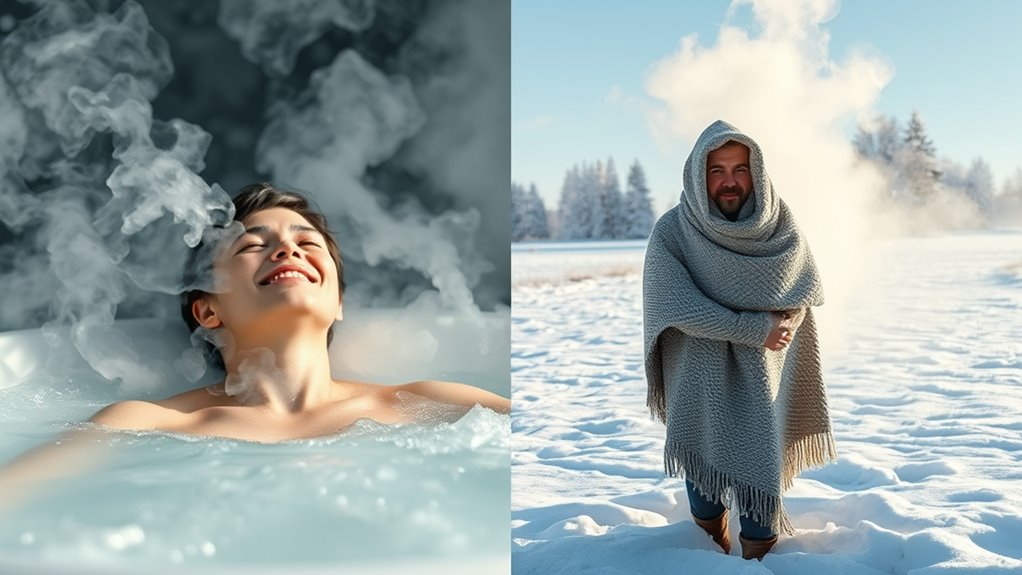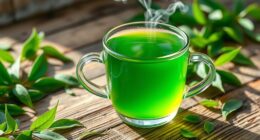Cold exposure and heat therapy activate your body’s natural stress responses, promoting resilience and metabolic efficiency through hormesis. By exposing yourself to controlled cold or heat, you stimulate beneficial adaptations like improved circulation, cellular repair, and increased energy. These practices help strengthen your body’s defenses without causing harm, encouraging long-term health benefits. To discover how to incorporate these therapies safely and maximize their effects, keep exploring the ways hormesis can boost your well-being.
Key Takeaways
- Small doses of cold or heat stimulate adaptive stress responses, enhancing resilience and overall health through hormesis.
- Cold exposure boosts metabolism and calorie burn by activating heat generation mechanisms like shivering and brown fat.
- Heat therapy promotes cellular repair and circulation via vasodilation and heat shock protein production.
- Regular temperature stressors improve mitochondrial function, metabolic flexibility, and immune resilience over time.
- Gradual, consistent application maximizes benefits while preventing overwhelm, leveraging the body’s natural hormetic adaptation.

Many people are turning to cold exposure and heat therapy as natural ways to boost recovery, improve circulation, and enhance overall well-being. These practices harness the body’s natural responses to environmental stressors, encouraging beneficial adaptations over time. When you expose yourself to cold or heat, your body initiates a metabolic adaptation—a series of physiological changes that improve your resilience and efficiency. For example, cold exposure triggers your body to generate heat through shivering and increases brown adipose tissue activity, which helps burn calories and produce warmth. Heat therapy, such as saunas or hot baths, promotes vasodilation, increasing blood flow and nutrient delivery to tissues. These responses aren’t just temporary; they set off a stress response that, when repeated consistently, enhances your body’s ability to handle future stressors more effectively.
Cold and heat therapies boost recovery and resilience through natural stress responses and metabolic adaptations.
The concept of hormesis plays an essential role here. Small doses of environmental stress, like cold or heat, stimulate your body’s defenses and repair mechanisms without causing harm. This hormetic effect encourages your body to become stronger and more adaptable. When you regularly expose yourself to these stressors, your metabolic pathways become more efficient. Cold exposure, for example, can increase mitochondrial density and improve your metabolic flexibility, making it easier for your body to switch between fuel sources. Similarly, heat therapy can promote heat shock proteins that help repair damaged cells and improve cellular function.
Your stress response is central to these benefits. When faced with cold or heat, your nervous system activates pathways that boost your resilience. Cold exposure, in particular, stimulates norepinephrine release, which not only sharpens focus but also reduces inflammation. Heat stress prompts your body to produce heat shock proteins, which protect cells from damage and support recovery. Over time, these responses strengthen your ability to cope with physical stress and may even have positive effects on mood and mental clarity. The key is to approach these therapies gradually, allowing your body to adapt without overwhelming it. Consistency is imperative, as repeated exposure solidifies these adaptations, leading to better recovery, improved circulation, and enhanced overall health.
In essence, cold exposure and heat therapy work by tapping into your body’s natural stress response, prompting metabolic adaptations that promote health and resilience. They exemplify hormesis, where small environmental challenges lead to significant long-term benefits. As you incorporate these practices thoughtfully, you’ll likely notice increased energy, better recovery, and a more robust physiological profile, all driven by your body’s remarkable ability to adapt and thrive.
Frequently Asked Questions
Can Cold Exposure or Heat Therapy Cause Long-Term Health Risks?
Cold exposure and heat therapy can pose long-term health risks if not employed carefully. You should prioritize long-term safety by conducting thorough risk assessments before starting these practices. While occasional use can be beneficial, overdoing it might lead to issues like nerve damage or cardiovascular stress. Always listen to your body, consult healthcare professionals, and confirm proper protocols to minimize risks and enjoy the health benefits safely.
What Are the Best Practices for Beginners Starting Hormesis Routines?
Starting hormesis routines is like planting a seed—you need patience and care. Begin with gradual adaptation, easing into cold or heat exposure slowly. Always prioritize safety precautions, listening to your body’s signals and avoiding extremes. Consult a healthcare professional if unsure. By taking small, consistent steps and respecting your limits, you build resilience safely and effectively, paving the way for long-term health benefits without risking setbacks.
Are There Specific Conditions That Contraindicate Cold or Heat Therapies?
You should avoid cold or heat therapies if you have certain medical contraindications, like cardiovascular issues, diabetes, or skin conditions. Always check for allergy considerations, especially if you’re sensitive to cold or heat. If you’re pregnant or have blood pressure problems, consult your doctor first. These precautions help prevent adverse reactions and guarantee safe practice, so never overlook underlying health conditions before starting hormesis routines.
How Often Should One Practice Cold Exposure or Heat Therapy for Optimal Benefits?
Think of your body as a garden that needs gentle watering to thrive. For ideal benefits, you should follow frequency guidelines, practicing cold exposure or heat therapy 2-4 times a week. This optimal scheduling helps your body adapt without overdoing it. Listen to your body’s signals, gradually increase exposure, and maintain consistency, ensuring your health garden flourishes with balanced stress and recovery.
Can These Therapies Replace Traditional Medical Treatments?
Cold exposure and heat therapy are great complementary healing options, but they shouldn’t replace traditional medical treatments. You can use these therapies as alternative options to support your health, yet it is crucial to consult your healthcare provider for serious conditions. They work best when combined with conventional care, offering additional benefits. Always prioritize professional advice and treat these therapies as part of a broader, integrated approach to your well-being.
Conclusion
Embracing cold exposure and heat therapy is like revealing nature’s secret garden of health. These practices act as a gentle wake-up call for your body, strengthening resilience and boosting well-being through hormesis. By regularly toggling between the chill and the heat, you turn your body into a finely tuned instrument. So, why not step outside your comfort zone? Your health’s symphony awaits, ready to play a vibrant tune when you harness these natural stressors.








